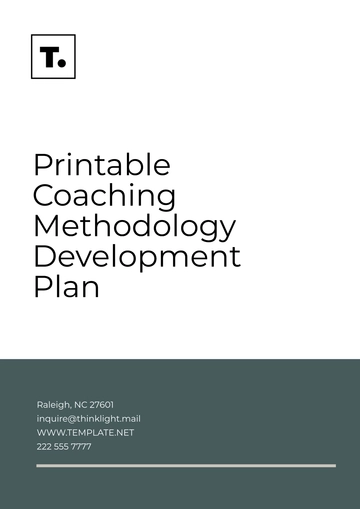Free Child Wellness Development Plan

Prepared by: [Your Name]
Company: [Your Company Name]
Date: [Insert Date]
I. Introduction
The development of a child is a multifaceted process that involves physical, cognitive, emotional, and social growth. The Child Wellness Development Plan is designed to provide a comprehensive guide to supporting children's overall well-being and development. This plan focuses on promoting healthy habits, building emotional resilience, fostering cognitive and social skills, and providing age-appropriate activities to stimulate growth in various domains.
II. Objectives
Promote Physical Health and Growth
Support children in maintaining a healthy lifestyle, focusing on nutrition, physical activity, and adequate rest.Enhance Cognitive Development
Foster critical thinking, problem-solving, and learning abilities through age-appropriate activities and educational strategies.Support Emotional and Social Well-being
Encourage emotional resilience, self-regulation, and healthy social interactions with peers and adults.Establish Healthy Habits
Help children develop routines around sleep, nutrition, hygiene, and physical activity that promote long-term wellness.Promote Positive Family Engagement
Encourage family involvement in the child’s development and create a strong foundation for emotional support and bonding.
III. Key Components of the Plan
A. Physical Health and Growth
Strategies:
Nutrition:
Provide a balanced diet, rich in fruits, vegetables, whole grains, lean proteins, and healthy fats to support growth and development.
Promote hydration by encouraging children to drink water throughout the day.
Limit sugary snacks, processed foods, and sodas to prevent childhood obesity and promote healthy eating habits.
Offer age-appropriate portion sizes and encourage family mealtimes to foster positive relationships with food.
Physical Activity:
Encourage daily physical activities such as running, jumping, biking, or swimming to promote cardiovascular health, strength, and coordination.
Introduce fun activities like dancing, playing tag, or sports to help children stay active while having fun.
Offer structured playtime as well as free play opportunities to promote gross and fine motor skills.
Sleep and Rest:
Promote healthy sleep routines, encouraging children to go to bed at the same time each night and ensuring they get the recommended amount of sleep for their age.
Create a calming bedtime routine that might include reading or listening to soft music to help children wind down.
Encourage naps for younger children to support their growth and energy levels.
B. Cognitive Development
Strategies:
Educational Play:
Engage children in age-appropriate educational activities that challenge their thinking and encourage problem-solving, such as puzzles, memory games, or building blocks.
Incorporate activities that stimulate creativity, such as drawing, painting, and crafting.
Encourage exploration and curiosity by introducing new concepts and ideas through books, games, and hands-on learning.
Language and Communication:
Foster language development by engaging in conversations, reading books, and encouraging children to express themselves verbally.
Introduce new vocabulary and encourage children to ask questions and explain their ideas.
Use songs, rhymes, and storytelling to improve literacy and cognitive skills.
Digital Literacy:
Set limits on screen time and encourage educational apps or programs that stimulate cognitive development, such as math games or reading apps.
Model healthy technology use by balancing screen time with physical and creative activities.
C. Emotional and Social Development
Strategies:
Self-Regulation:
Teach children how to identify and express their emotions in healthy ways through role-playing and discussions.
Introduce coping strategies for handling frustration, anger, and anxiety, such as deep breathing, taking breaks, or using positive self-talk.
Building Resilience:
Help children understand that mistakes are part of learning and growth. Encourage a “growth mindset” that emphasizes effort and perseverance.
Praise children for their efforts, not just their achievements, to foster confidence and motivation.
Social Skills:
Provide opportunities for children to interact with peers, such as playdates, group activities, or team sports.
Encourage sharing, taking turns, and practicing empathy in social settings.
Teach conflict resolution skills, emphasizing the importance of listening and respecting others' feelings.
Positive Role Models:
Be a positive role model by displaying healthy emotional expression, respectful communication, and empathy toward others.
Encourage family members to model behaviors that promote emotional intelligence and resilience.
D. Establishing Healthy Habits
Strategies:
Routine and Structure:
Establish consistent daily routines that include time for meals, play, study, and rest. A structured environment helps children feel secure and understand expectations.
Use visual schedules or charts to help children track daily activities and transitions.
Hygiene and Self-care:
Encourage regular handwashing, brushing teeth, and bathing to promote hygiene and prevent illness.
Teach children how to take care of their own needs as they develop, such as combing their hair or picking out clothes.
Mental Wellness:
Provide a calm and safe environment for children to express their thoughts and emotions.
Engage in mindfulness or relaxation exercises, such as deep breathing, to help children manage stress.
E. Family Engagement and Support
Strategies:
Positive Family Involvement:
Encourage family bonding through shared activities, such as family walks, board games, or cooking together.
Set aside quality time for one-on-one interactions with each child to strengthen relationships and ensure emotional support.
Open Communication:
Maintain open communication with children, listening actively to their concerns, feelings, and ideas.
Establish a strong foundation of trust, where children feel comfortable talking to parents or caregivers about any issues they face.
Parenting Education and Support:
Offer resources and information on child development to parents and caregivers, helping them understand their child’s needs and how to support growth effectively.
Provide or suggest parenting workshops, support groups, or counseling to help parents with challenges and promote positive parenting practices.
IV. Implementation Timeline
Phase 1 (Birth to 3 Years):
Focus on physical bonding, building foundational language skills, and introducing structured routines.
Encourage sensory exploration and motor development activities (e.g., tummy time, finger painting).
Support parents with resources and tips for early childhood development.
Phase 2 (3 to 6 Years):
Increase opportunities for social interaction with peers and structured play.
Introduce early educational activities, including reading, basic math, and problem-solving games.
Foster independence through self-care practices and participation in household tasks.
Phase 3 (6 to 12 Years):
Focus on cognitive development through schoolwork, creative projects, and team sports.
Encourage emotional growth through conflict resolution, self-regulation, and resilience-building activities.
Promote social skills through group activities, clubs, and social events.
Ongoing:
Continue encouraging a healthy lifestyle with balanced routines, exercise, and nutrition.
Offer consistent emotional support and guidance as children navigate their development.
V. Monitoring and Evaluation
A. Key Performance Indicators (KPIs)
Improvement in physical health markers (e.g., growth, fitness).
Cognitive milestones such as reading, problem-solving, and memory.
Emotional development is indicated by the ability to manage stress, express feelings, and interact with peers.
Social skills development is demonstrated through positive relationships with family, peers, and community members.
B. Evaluation Methods
Regular check-ins through developmental assessments, questionnaires, and feedback from parents and teachers.
Periodic monitoring of the child’s physical, cognitive, and emotional progress through interviews, reports, or observations.
VI. Resources and Tools
Educational Resources:
Books, apps, and online platforms focused on age-appropriate learning and activities.
Physical Health:
Recommended fitness activities, videos, or programs for children.
Mental and Emotional Wellness:
Resources on coping strategies, mindfulness techniques, and emotional intelligence activities.
Parenting Support:
Workshops, online courses, and books for parents on child development and wellness.
VII. Conclusion
The Child Wellness Development Plan is a comprehensive approach that aims to nurture children’s growth in all areas of their life, from physical health to emotional well-being. By incorporating healthy routines, engaging educational activities, and fostering positive relationships, this plan provides children with the tools they need to thrive and develop into well-rounded individuals. Active family involvement and ongoing support are essential to ensure that children continue to grow, learn, and adapt as they move through each developmental stage.
- 100% Customizable, free editor
- Access 1 Million+ Templates, photo’s & graphics
- Download or share as a template
- Click and replace photos, graphics, text, backgrounds
- Resize, crop, AI write & more
- Access advanced editor





























